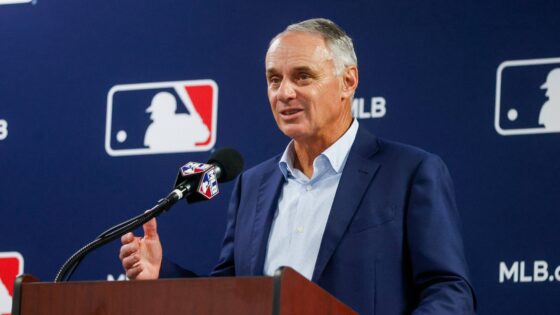In a league where the scoreboard tells one story and the balance sheet whispers another, MLB finds itself navigating more than just pitch counts and pennant races. As retired legends are suddenly back in uniform—just without the cleats—Major League Baseball is drawing scrutiny for its off-field lineup choices. When diplomacy starts looking like strategy, and strategy smells like leverage, you can bet the union’s radar is lighting up.
MLB and the MLB Players Association have never looked eye to eye. But when it comes to pointing fingers, these two have a very fierce competition, and things are heating up again. With the threat of another lockout looming, the MLBPA is playing all its cards, and this time, the card is connected to some former players.
In a recent interview with The Athletics, MLBPA Executive Director Tony Clark and Deputy Director Bruce Meyer talked about the tactics Manfred is using to get the players on his side. Clark shared the advise he often gives players in CAP: “Stay away from the conversations about labor.” Joining the conversation, Meyer added, “There are players who are being paid by MLB… going with Rob to the locker rooms… trying to sell players on a system that this union has historically thought was bad.”
In 2023, Major League Baseball launched the Commissioner’s Ambassador Program (CAP), a strategic outreach initiative. Formed by commissioner Rob Manfred, CAP enlists respected, retired big leaguers to improve player relations. These ambassadors attend league events, advise current players, and represent MLB in various community and international efforts. The group includes high-profile names like CC Sabathia, Ryan Howard, and Jimmy Rollins in leadership roles.
The stated goal of CAP is to grow the game and build stronger relationships across generations. Members also accompany Manfred during clubhouse visits and assist with on-field, media, and development efforts. CAP currently boasts a roster of 19 former stars, including Dexter Fowler, Prince Fielder, and Gary Sheffield. Their influence and visibility give the group credibility with both fans and active players.
Image: MLB.com
However, the MLB Players Association views CAP’s role with increasing suspicion, especially amid labor tensions. Union leaders believe the program is being used to promote changes like a potential salary cap.
These tensions come at a time when the league’s economic structure is under renewed scrutiny and stress. Manfred has pointed to competitive imbalance and media revenue losses as reasons for systemic change. Meanwhile, Clark continues to oppose any cap, calling it “institutionalized collusion” that harms player freedom. Both sides are preparing for difficult CBA talks as the current agreement expires after 2026.
With the risk of a lockout looming, collaboration between MLB and the union is crucial for the sport’s health. Players like Pete Alonso have voiced concern that another strike could cost the league valuable time. Disruption at the bargaining table could fracture fan trust and deepen division within the player community. For baseball’s future, resolution—not escalation—should be the shared goal before the next deadline arrives.
The scoreboard might not show it, but the real battle is happening in press rooms and boardrooms. What started as a goodwill tour now looks like a chess match—complete with pawns, kings, and very public checkmates. As when retired players become the message, someone’s definitely managing the spin rate.
Amid tensions, MLB commissioner pushing hard for salary cap
Commissioner Manfred, never one to bunt in a boardroom, has quietly made economic reform his long game. As players brace for another potential labor war, the salary cap debate is heating up. And if recent moves—like deploying retired stars as soft-power surrogates—are any clue, this won’t be a silent inning.
Major League Baseball’s payroll landscape is starting to resemble a luxury mall beside a dollar store. While ten franchises strut around with payrolls north of $200 million, three others are barely scraping the $100 million mark. The Yankees and Mets throw money like it grows in their outfield grass. Meanwhile, others watch from the dugout shadows, seemingly content with silence and a shoestring budget.
Manfred isn’t naming names, but he’s clearly circling the problem in red ink. Manfred claims fans in low-spending markets are losing faith in their team’s ambition. And if the spending gap keeps widening, baseball’s middle class might vanish like a bunt in a home run derby.
For him, this isn’t just a matter of dollars—it’s about keeping the sport believable. When half the league feels priced out before Opening Day, the product begins to rot. The issue isn’t just how much is being spent, but where and why it matters. If owners can’t agree on fairness, the next labor deal might be settled with picket signs, not pens.
Baseball might still be America’s pastime, but its economic playbook is stuck in extra innings. Manfred’s soft diplomacy is starting to feel like a hard sell, and the union isn’t buying. A game built on box scores now faces a battle over balance sheets and bargaining chips. If MLB can’t fix its fiscal field, fans won’t need a scorecard—they’ll need a calculator. After all, you can’t cry competitive balance while handing out billion-dollar bullpens.
The post MLB Commissioner Faces Heat for Allegedly Causing Rift as Salary Cap Debate Intensifies appeared first on EssentiallySports.
